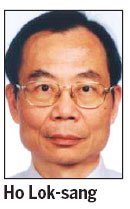Railway plans to serve better, serve more
Updated: 2013-03-26 06:08
By Ho Lok-Sang(HK Edition)
|
|||||||||
The development of Hong Kong's Mass Transit Railway (MTR) system is of utmost importance to Hong Kong society. Hong Kong is a world city with a population of more than 7 million, over one-and-a-half times New Zealand's population, yet all squeezed within a tiny space of 1,100 square kilometers. The proper configuration of its rail network will make a huge difference to social and economic life.
There are a few basic principles with regard to railway system configuration. The first is that long trips should be fast, with relatively few stops, and that long railway lines should have good interchanges to railway lines that serve local travel, where more stops should be offered.
For example, there is now the proposal to link the Tung Chung Line with the Tseung Kwan O Line. The distance from Tung Chung to Tseung Kwan O (32 km) is long. For this line, ideally over the range where it runs parallel to the existing Island Line, there should be relatively few stops. Passengers who want to get off anywhere between Admiralty and North Point should be able to change trains at Admiralty or North Point for the existing Island Line for local traffic.
In comparison with this "Interchange" plan, the so-called "Swap" plan is neither here nor there. The Tseung Kwan O Line is to be extended all the way to Kennedy Town while the Tung Chung Line is to be extended all the way to Chai Wan. Both are very long routes, and both fail to serve local stops. For example, anyone who wants to travel from Fortress Hill to Tin Hau, or Wan Chai, would need to backtrack to change to the other line to complete the journey. As such, the "Swap" concept is inferior to the "Interchange" concept.

A second principle is to look for the most cost-effective new linkages thereby enhancing synergy between existing lines. With this principle in mind, I would identify one key shortcoming of the Tung Chung Line and the Airport Express Line. The Tung Chung Line is linked to the Tsuen Wan Line only at Lai King, and is linked to the West Rail Line only at Nam Cheung. The Airport Express Line, moreover, has a stop at Tsing Yi and Kowloon, where it links with the Tung Chung Line, but neither links with the West Rail Line, nor the Tsuen Wan Line.
Accordingly, I would propose a link between Tsing Yi and Tsuen Wan West, and another between Tsuen Wan West and Tsuen Wan. This way the Airport Express Line and the Tung Chung Line, as well as the West Rail Line, will all become accessible to the huge population in Tsuen Wan, Tai Wo Kau, and Kwai Hing. By these proposed extensions, it is expected that users of the Airport Express Line will increase tremendously, allowing improved frequency. The benefits will be substantial.
By the same token, the West Rail Line's Austin station and the Tung Chung Line's Kowloon station need to be better connected. The connection needn't be a train - perhaps a tunnel with a moving walkway will make a huge difference in the utilization of the Airport Express, the West Rail, and the Tung Chung lines. The proposed links - one between Tsing Yi and Tsuen Wan West, and one between Tsuen Wan West and Tsuen Wan - are both less than one kilometer in length. I cannot comment on the engineering aspect of the links, but can stress that these short links will link up the Airport Express and the Tung Chung Line to the West Rail Line and the Tsuen Wan Line, leading to huge synergy between lines.
A third principle is that sufficient population mass should justify a railway extension, subject to construction cost. That principle certainly justifies the proposed West Rail Line extension to Tuen Mun Pier and the proposed Island Line extension, or feeder line to Siu Sai Wan. Both destinations are not that far from an existing railway stop, namely Tuen Mun and Heng Fa Chuen, and both are densely populated.
Finally, along with ongoing consultation about railway line development is the need to address the pricing issue. One of the main objections of people living in the Northwest New Territories is the high cost of travel. But, given that the West Rail Line is already in operation, segregation of communities because of high travel costs should now be history. Lowering the fares will allow Hong Kong's communities to integrate. Workers will have more job opportunities and employers will have a bigger pool of workers to choose from. Meanwhile the government will face less of an objection when it proposes locating new public-housing projects in the new towns. It is high time we recognize it is the social returns to the investment that count, and not so much the private returns. Most importantly, a well-designed system with smart pricing will enable Hong Kong to have healthier and happier communities.
The author is director of the Centre for Public Policy Studies at Lingnan University.
(HK Edition 03/26/2013 page9)